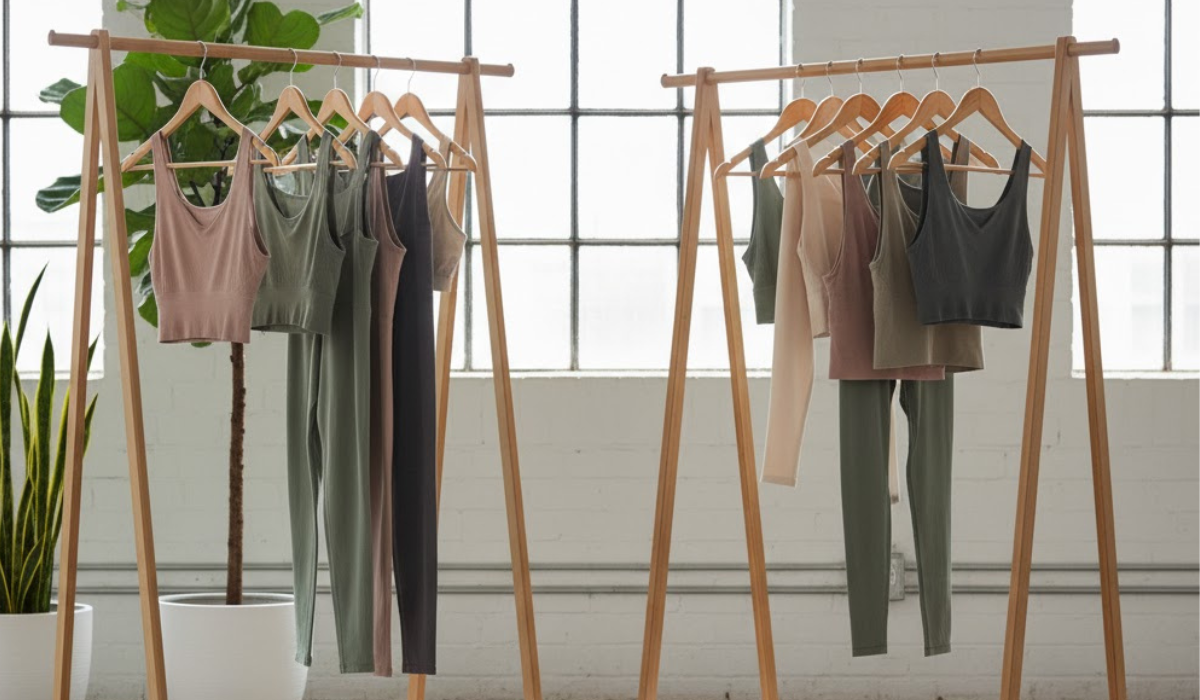In recent years, the term fast fashion has become one of the most debated phrases in the clothing industry. It refers to the rapid production of inexpensive clothing that mimics the latest runway trends, often at the cost of the environment, garment workers’ welfare, and long-term quality. But where does Fabletics, a brand co-founded by actress Kate Hudson in 2013, fit into this picture?
Does Fabletics fall into the fast fashion category, or does it operate differently? To answer this question, we need to look deeper into its business model, production processes, sustainability claims, and ethical considerations.
Understanding Fast Fashion
Before labeling any brand as fast fashion, it’s important to define what the term really means. Fast fashion refers to:
- Rapid design and manufacturing cycles that bring new clothing collections to market in a matter of weeks.
- Mass production of inexpensive garments that encourage frequent buying and short-term use.
- Low-cost materials and labor, often tied to exploitative working conditions.
- A business model built around volume—selling as many items as possible, as quickly as possible.
Brands like Shein, H&M, and Zara are often cited as leading examples of fast fashion due to their constant product turnover and accessibility-driven pricing.
Fabletics: The Brand Overview
Fabletics began as an online activewear brand offering stylish and affordable workout clothing through a subscription-based model. It quickly gained popularity for its blend of fashionable athleisure designs and celebrity-backed marketing. Members could subscribe to receive new outfits every month at discounted prices—a model that drove both loyalty and repeat purchases.
The company now operates both online and in physical retail stores, expanding beyond women’s activewear into men’s apparel, swimwear, and lifestyle clothing.
But with its wide variety of frequently released designs and competitive pricing, many people wonder: Is Fabletics part of the fast fashion industry?
Analyzing Fabletics Through the Fast Fashion Lens
Let’s evaluate Fabletics by breaking down the main characteristics of fast fashion and seeing how the brand compares.
1. Speed of Production
Fabletics does release new collections regularly, often aligning with seasons or fitness trends. However, unlike ultra-fast fashion brands that drop hundreds of new items every week, Fabletics’ product turnover is relatively moderate.
The brand focuses on curated collections, which means it emphasizes cohesive outfit sets rather than endlessly churning out random pieces. This approach slows down consumption slightly, though it still encourages frequent buying through its monthly membership perks.
Verdict: Moderately fast-paced, but not extreme.
2. Pricing and Quality
One hallmark of fast fashion is low prices that often reflect cheap materials and poor durability. Fabletics offers mid-range prices—higher than budget brands like Shein, but lower than premium athletic labels like Lululemon.
The quality of Fabletics garments tends to be better than typical fast fashion items. Many users report that their leggings, bras, and tops hold up well through multiple washes and workouts. Still, some customers have experienced inconsistencies in fit and durability, which could stem from mass production methods.
Verdict: Better quality than fast fashion, but still driven by affordability.
3. Labor Practices and Transparency
Ethical labor practices are one of the most important indicators of whether a brand aligns with fast fashion principles. Fabletics states that it partners with “ethical manufacturing facilities” that follow fair labor standards. However, the brand has not always been fully transparent about its supply chain details.
Unlike some sustainability-focused companies, Fabletics does not publicly list all its suppliers or provide detailed reports about working conditions, wages, or factory audits. This lack of transparency makes it difficult for consumers to independently verify the brand’s claims.
Verdict: Unclear—ethical claims exist, but transparency is limited.
4. Environmental Impact and Sustainability Efforts
Fast fashion has a massive environmental footprint due to overproduction, synthetic fabrics, and textile waste. Fabletics has taken some steps toward sustainability, though its efforts remain relatively modest.
Some initiatives include:
- Recycled fabrics: Certain collections use recycled polyester and nylon blends.
- Reduced packaging: The brand has been shifting to more eco-friendly packaging materials.
- Carbon awareness: Fabletics has discussed goals for carbon reduction but hasn’t released comprehensive sustainability reports.
While these efforts are positive, they don’t necessarily make the brand sustainable. The subscription model still encourages frequent consumption, which can contribute to waste even if individual garments are higher quality.
Verdict: Partially sustainable, but not a sustainability-focused brand.
5. Marketing and Consumer Psychology
Fabletics’ marketing relies heavily on lifestyle imagery, celebrity endorsements, and “VIP membership” discounts. This creates a sense of exclusivity and urgency that can push consumers to purchase regularly — a hallmark of fast fashion behavior.
However, unlike many fast fashion platforms, Fabletics offers guidance for long-term use, such as care instructions and outfit reusability tips. This shows some awareness of responsible consumption, though the underlying business model still relies on ongoing purchases.
Verdict: Encourages repeat buying but also promotes some mindful messaging.
So, Is Fabletics Fast Fashion?
The answer is nuanced.
Fabletics does share certain similarities with fast fashion, such as frequent product releases, affordability-driven marketing, and a high-consumption model. However, it also differs in key areas—better quality control, more thoughtful design processes, and emerging sustainability initiatives.
In short:
- Fabletics is not ultra-fast fashion, but it’s not fully slow fashion either.
It operates in a gray area — a mid-tier athleisure brand that borrows aspects from both models.
The Ethical Consumer’s Perspective
As consumers become more conscious of their impact, understanding where a brand stands on the fast fashion spectrum is crucial. Here’s what mindful shoppers should consider when buying from Fabletics:
- Evaluate your needs. Buy only what you’ll actually wear and use long-term.
- Check for recycled or sustainable materials. Support collections that use eco-friendly fabrics.
- Cancel unnecessary subscriptions. If you’re not using the monthly membership, opt out to reduce wasteful consumption.
- Look for transparency updates. Keep an eye on Fabletics’ sustainability and ethical reports.
By making thoughtful choices, you can enjoy activewear that aligns better with your values — regardless of whether a brand fully meets the “sustainable” label yet.
The Future of Fabletics and Sustainable Activewear
The activewear market is evolving quickly, and sustainability is becoming a key factor for brand survival. Consumers are demanding more transparency and accountability from the companies they support.
If Fabletics wants to distance itself from fast fashion completely, it will need to:
- Publish detailed sustainability and labor reports.
- Increase the use of renewable or biodegradable fabrics.
- Develop recycling or garment take-back programs.
- Emphasize quality longevity over rapid consumption.
The brand has potential to bridge the gap between affordability and ethics—but only if it continues evolving toward more transparent, circular production models.
Conclusion
So, is Fabletics fast fashion?
Not entirely—but it isn’t completely free from the traits of fast fashion either.
Fabletics sits somewhere in the middle, offering accessible activewear that’s more durable and ethically aware than many ultra-fast competitors, yet still reliant on mass production and subscription-driven consumption.
For conscious consumers, the takeaway is clear: enjoy what Fabletics offers, but approach your wardrobe mindfully. The true power to combat fast fashion lies in how often—and why—we choose to buy.
Informational FAQs
1. What is considered fast fashion?
Fast fashion refers to inexpensive, trendy clothing that’s quickly produced and sold to meet current trends. It often involves low-cost labor, poor-quality materials, and environmental harm.
2. Does Fabletics use sustainable materials?
Some Fabletics collections include recycled fabrics, but not all garments are made with sustainable materials. The brand is moving in a more eco-friendly direction but hasn’t reached full sustainability.
3. Is Fabletics ethical?
Fabletics claims to work with ethical factories, though public data about its supply chain is limited. More transparency would help consumers verify these claims.
4. How does Fabletics compare to Lululemon in terms of sustainability?
Lululemon has made more visible commitments to sustainability reporting and recycled materials. Fabletics is improving, but it’s still developing in this area.
5. Can Fabletics be part of a slow fashion wardrobe?
Yes, if consumers buy selectively and focus on long-lasting items. Avoid overconsumption and prioritize pieces you’ll wear frequently.

